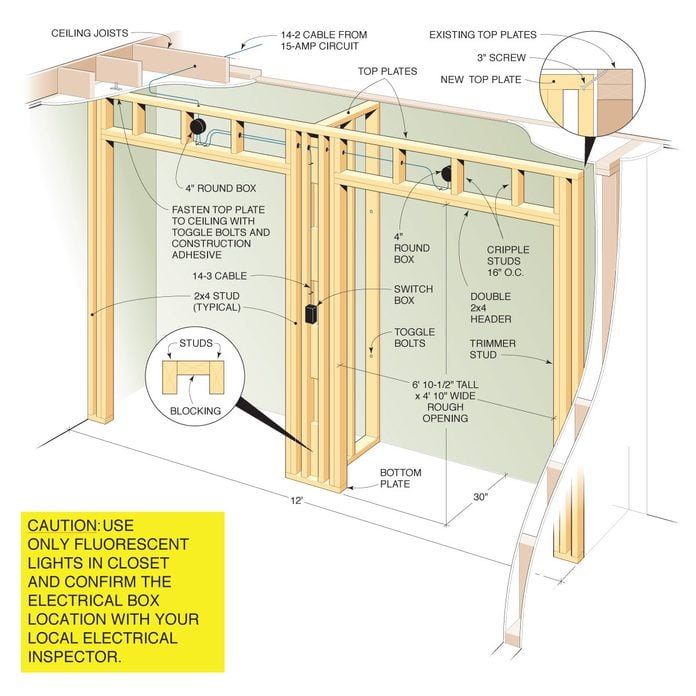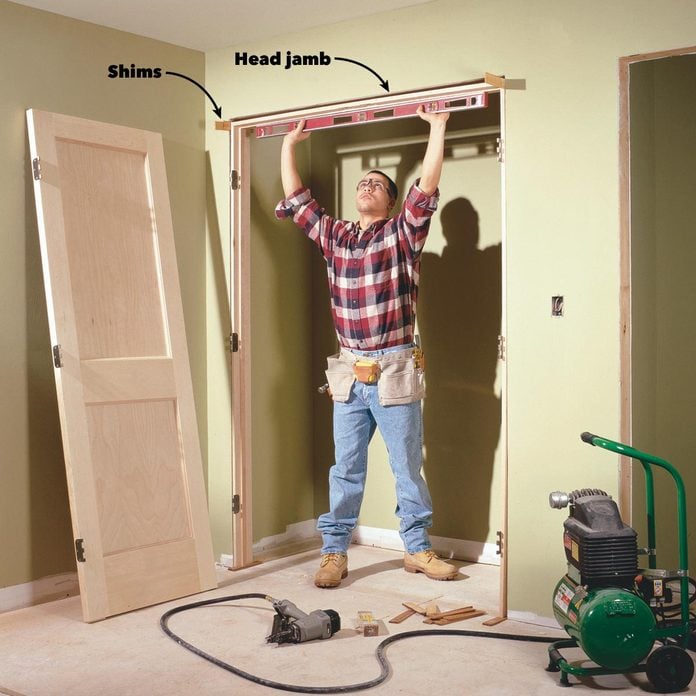Adding A Closet To A Bedroom
How to Build a Wall-to-Wall Closet with Doors
Steal a few feet from the end of your bedroom and add a wall-to-wall closet with doors. Here are the step-by-step instructions.
![]() Time
Time
Multiple Days
![]() Complexity
Complexity
Intermediate
![]() Cost
Cost
$501-1000
Introduction
Need more closet space? You gain tons of storage space by stealing a few feet from a room and building a new closet, complete with double doors. Finally you'll have room enough for that mound of shoes, the clothes packed on closet rods and the pile of boxes. In this article, we'll show you how to build a closet like this, concentrating on framing simple walls and hanging double doors.
Tools Required
Materials Required
- 1/2-in. drywall
- 16d nails
- 2x4s
- 3-in. drywall screws
- 8d finish nails
- Construction adhesive
- Double doors
- Shims
- Toggle bolts
Closet planning and prep work
This built in closet isn't complex. It's basically the same concept as how to frame a wall with a door. An energetic beginner could complete it successfully in about four weekends. You probably don't need a building permit for the closet, but if you add closet lighting you'll need an electrical permit. Contact your local building department to be sure.
In addition to basic carpentry and drywall tools, you'll need a circular saw to cut the framing lumber, a drill to drive screws and a power miter box to cut new trim. You could install the doors and trim with hand tools, but a pneumatic nail gun and power miter box will make the job a lot easier and more enjoyable. You can rent a nail gun and compressor and a power miter box.
Find a good closet location. You can easily modify our plan to build closets wherever they'll fit. Reduce the door width to fit narrower rooms, or build a closet with one set of doors. If you'll be hanging clothes, make sure the closet interior is at least 26 in. deep. Adjust the closet dimensions to avoid conflicts with electrical boxes, heat ducts and windows.
We chose hinged double doors for our closet because they're sturdier and less troublesome than bifold doors. Order your two sets of doors prehung from a full-service lumberyard or home center. For 2×4 walls with 1/2-in. drywall on each side, order doors with 4-9/16 in. wide jambs. Request roller catches at the top of the doors to hold them shut. Remember, though—hinged doors need space to swing open. If floor space is limited in front of the closets, consider bifold doors instead. Ask for rough-opening dimensions when you order the doors
Then get started with the prep work. If your room is carpeted, roll the carpet back out of the way and pry up the tackless strips (wear leather gloves—the barbs on tackless strips are wickedly sharp). Protect hardwood, tile and vinyl floors by taping down two layers of heavy kraft paper plus a layer of thin plywood or hardboard. Carefully pry off the baseboard with a flat pry bar. If you plan to reuse it, pull the nails through the backside. Plus: Check out these other cheap closet updates you can DIY.
Project step-by-step (16)
Step 1
Frame the walls for a new closet with doors
Figure A: Closet Framing Details

Use a stud finder to locate and mark the framing members where the new wall butts into the existing walls and ceiling. If possible, attach the new wall plates and studs to existing framing members with 3-in. screws. Otherwise, use the method shown in Photo 4.
If you plan to add closet lights, locate an electrical box that can provide a power source and plan the cable route. If you're unsure how to do this, call a licensed electrician to help you wire and install the lights. Photos 1 – 4 show how to chalk lines for and attach the top and bottom plates. Use perfectly straight 2x4s when you plumb up from the bottom plate to mark the ceiling (Photo 3). Be precise—mistakes here will cause crooked walls that will haunt you when it comes time to install the doors.
With the plates installed, completing the walls is a simple matter of measuring for and cutting the studs, door trimmers and cripples to fit. Add about 1/16 in. to your measurements when you cut the studs. It's much easier to toe-screw tight-fitting studs. Attach the studs to the walls with construction adhesive and toggles or by nailing to an existing stud. When you use toggles, hold the 2x4 in place, drill the toggle locations (about 2 ft. apart with a 1/4-in. bit through both 2x4 and drywall). Then remove the 2x4 and drill the drywall with a 5/8-in. spade bit. Mount the toggles to the 2x4 (Photo 4), spread the adhesive, and shove the toggle wings through their holes.
Pick straight lumber for the studs and trimmers and cut up crooked lumber for the short cripples. See Fig. A for trimmer stud and header lengths. Measure for the cripples after you install the header.
Step 2
Lay out the closet walls

Roll back the carpet and pry off the baseboard. Then measure out 30 in. and chalk a line parallel to the wall.
Sign Up For Our Newsletter
Complete DIY projects like a pro! Sign up for our newsletter!
Do It Right, Do It Yourself!
![]()
Step 3
Cut the top and bottom wall plates

Cut 2x4s to fit between the walls for the top and bottom plates and mark the position of the studs, door openings and intersecting wall on both (Fig. A). Align the outside edge of the bottom plate with the chalk line and screw or nail it to the floor. Don't fasten the plate where the door opening will be; you'll cut it out later.
Step 4
Mark the top plate position

Plumb up from the bottom plates with a straight 2x4 and 4-ft. level and mark the top plate location on the ceiling. Snap chalk lines between the marks. Locate the ceiling joists with a stud finder or by rapping with your knuckle, then mark them where they cross the top plate. Our ceiling joists run parallel to our new wall.
Step 5
Attach the top plate

Screw the top plate to the joists with 3-in. screws where they intersect, or attach the plates with construction adhesive and 1/4-in. x 4-in. toggle bolts where there are no joists to screw into. Secure the ends of the plates with 3-in. drywall screws driven at an angle to catch ceiling nailers (Fig. A).
Step 7
Install the headers

Nail together the 2x4 headers with 16d nails, set them on top of the trimmers, and nail them to the studs. Cut and toe-screw the cripples to the top plate and header.
Step 8
Install the doors
If you want closet lighting, rough in the electrical cable and boxes now and have your work inspected before you hang the drywall. Hang, tape and sand the drywall. Then prime and paint the walls before you install the new doors and trim.
The type of floor covering in your room will affect how you install the door jamb. For hard surfaces like wood flooring or ceramic tile, set the jambs directly on the floor. If your floor is slightly out of level, you'll have to scribe and saw off the bottom of one of the side jambs to make the head jamb level. If your floor will be carpeted, shim under one side jamb to level it (Photo 7). The carpet and pad will cover up the shims. Allow about 1/2-in. clearance to the finished floor. For thick carpet, you may have to raise the entire door frame with extra shimming. Measure the carpet height and door clearance to find out.
Follow the steps in Photos 7 – 11 to install the door jambs. The strategy for getting a strong, square frame is to shim the door frame at the top and bottom and behind each hinge location (Photos 8 – 10). Initially drive one 8d finish nail through each set of shims. Don't cut them off yet. Rehang the doors and check the fit. In most cases, you'll have to adjust the jamb by driving the shims in or out to get the doors to line up. Your goal is to create an even gap all around the doors. When you're happy with the fit, add a second nail at each location and a 3-in. screw through each of the top hinges into the door trimmer stud (Photo 12). Score the shims with a sharp utility knife and snap them off flush with the jambs.
If the doors don't quite close flush with each other at the bottom, either the jamb is twisted because the walls are out of plumb, or the doors are warped. In either case, the solution is to push the top and bottom of opposing jambs in opposite directions until the doors line up (Photo 11). This may make installing trim more difficult, since the jambs will no longer be exactly flush with the drywall.
Install door trim and baseboard that match the trim in your room. If you're not experienced in carpet installation, call in a pro to cut, stretch and re-lay the carpet.
Then measure the closet interior and go shopping for closet organizers. We outfitted our closet with off-the shelf Melamine components available at home centers and lumberyards. Next, learn some fantastic framing tips from pros.
Step 9
Level the door jamb

Center the door jamb in the opening and wedge it tight by sliding in a pair of shims at each top corner. Set a 4-ft. level against the head jamb to check for level.
Step 10
Detail of door jamb bottom

Shim under the side jamb on the low side until the head jamb is exactly level.
Step 11
Shim the side jamb until plumb and nail

Drive one 8d finish nail through the jambs and shims at the top on each side. Set a 4-ft. level on one jamb and plumb it by sliding pairs of shims behind each hinge and at the bottom of the jamb. Drive one finish nail into each set of shims. Double-check for plumb and adjust by tapping shims in or out.
Step 12
Align the second side jamb with a spacer

Cut a 1x2 spacer to fit snugly between the jambs at the top of the door frame. Insert the spacer at each hinge location and shim and nail the opposite jamb.
Step 13
Hang the doors

Hang the doors in the frame. Adjust the shims until the space between the two doors is even from top to bottom and the doors line up across the top. Then drive a second nail at each shim location. Add shims at the top center to stiffen the top jamb.
Step 14
Fine tune the fit

Align the door bottoms by tapping the door jambs slightly in or out until they're even. Use a block of wood and firm hammer blows. Then drive in additional nails to secure the jamb in the new location.
Step 15
Strengthen the hinges

Replace the center screw in the jamb half of the top hinges with a 3-in. screw the same or a similar color. Drive the screw through the jamb and into the 2x4 door framing to add extra support and keep the door from sagging over time. Double-check the space between the doors and add a shim if necessary.
Step 16
Trim the doors with casing

Mark and cut trim to fit around each opening. Fasten the trim with pairs of finish nails placed about 16 in. apart and driven into the door jamb and framing. Install the roller catches at the door tops, and dummy knobs that match your décor. And like that you have a closet with doors.
Source: https://www.familyhandyman.com/project/how-to-build-a-wall-to-wall-closet/

0 Komentar